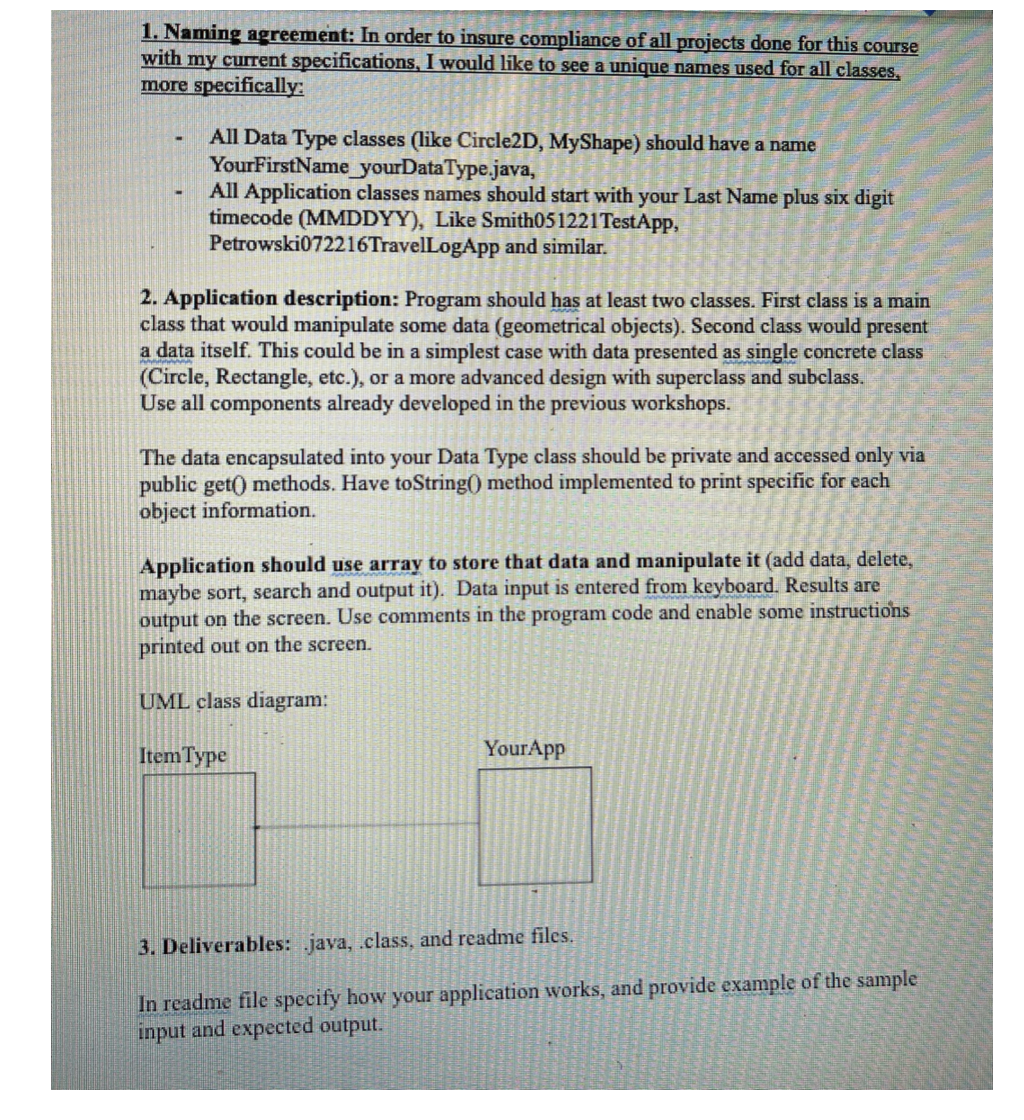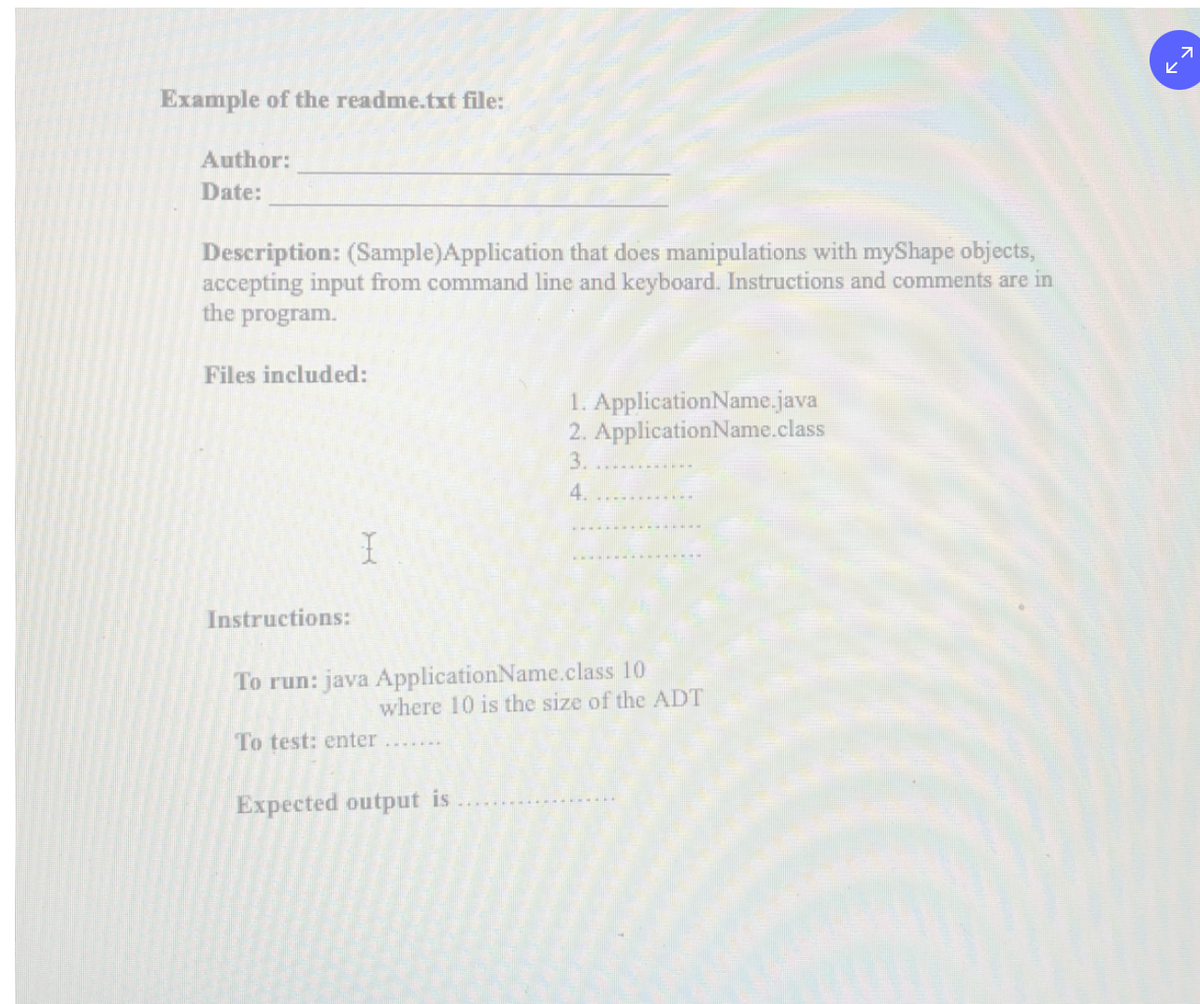1. Naming agreement: In order to insure compliance of all projects done for this course with my current specifications, I would like to see a unique names used for all classes, more specifically: All Data Type classes (like Circle2D, MyShape) should have a name YourFirstName _yourDataType.java, All Application classes names should start with your Last Name plus six digit timecode (MMDDYY), Like Smith051221TestApp, Petrowski072216TravelLogApp and similar. 2. Application description: Program should has at least two classes. First class is a main class that would manipulate some data (geometrical objects). Second class would present a data itself. This could be in a simplest case with data presented as single concrete class (Circle, Rectangle, etc.), or a more advanced design with superclass and subclass. Use all components already developed in the previous workshops. The data encapsulated into your Data Type class should be private and accessed only via public get() methods. Have toString() method implemented to print specific for each object information. Application should use array to store that data and manipulate it (add data, delete, maybe sort, search and output it). Data input is entered from keyboard. Results are output on the screen. Use comments in the program code and enable some instructions printed out on the screen. UML class diagram: Item Type YourApp 3. Deliverables: java, .class, and readme files. In readme file specify how your application works, and provide example of the sample input and expected output. ビ Example of the readme.txt file: Author: Date: Description: (Sample)Application that does manipulations with myShape objects, accepting input from command line and keyboard. Instructions and comments are in the program. Files included: 1. ApplicationName.java 2. ApplicationName.class 3. 4. Instructions: To run: java ApplicationName.class 10 where 10 is the size of the ADT To test: enter....... Expected output is 下、
1. Naming agreement: In order to insure compliance of all projects done for this course with my current specifications, I would like to see a unique names used for all classes, more specifically: All Data Type classes (like Circle2D, MyShape) should have a name YourFirstName _yourDataType.java, All Application classes names should start with your Last Name plus six digit timecode (MMDDYY), Like Smith051221TestApp, Petrowski072216TravelLogApp and similar. 2. Application description: Program should has at least two classes. First class is a main class that would manipulate some data (geometrical objects). Second class would present a data itself. This could be in a simplest case with data presented as single concrete class (Circle, Rectangle, etc.), or a more advanced design with superclass and subclass. Use all components already developed in the previous workshops. The data encapsulated into your Data Type class should be private and accessed only via public get() methods. Have toString() method implemented to print specific for each object information. Application should use array to store that data and manipulate it (add data, delete, maybe sort, search and output it). Data input is entered from keyboard. Results are output on the screen. Use comments in the program code and enable some instructions printed out on the screen. UML class diagram: Item Type YourApp 3. Deliverables: java, .class, and readme files. In readme file specify how your application works, and provide example of the sample input and expected output. ビ Example of the readme.txt file: Author: Date: Description: (Sample)Application that does manipulations with myShape objects, accepting input from command line and keyboard. Instructions and comments are in the program. Files included: 1. ApplicationName.java 2. ApplicationName.class 3. 4. Instructions: To run: java ApplicationName.class 10 where 10 is the size of the ADT To test: enter....... Expected output is 下、
Database System Concepts
7th Edition
ISBN:9780078022159
Author:Abraham Silberschatz Professor, Henry F. Korth, S. Sudarshan
Publisher:Abraham Silberschatz Professor, Henry F. Korth, S. Sudarshan
Chapter1: Introduction
Section: Chapter Questions
Problem 1PE
Related questions
Question

Transcribed Image Text:1. Naming agreement: In order to insure compliance of all projects done for this course
with my current specifications, I would like to see a unique names used for all classes,
more specifically:
All Data Type classes (like Circle2D, MyShape) should have a name
YourFirstName _yourDataType.java,
All Application classes names should start with your Last Name plus six digit
timecode (MMDDYY), Like Smith051221TestApp,
Petrowski072216TravelLogApp and similar.
2. Application description: Program should has at least two classes. First class is a main
class that would manipulate some data (geometrical objects). Second class would present
a data itself. This could be in a simplest case with data presented as single concrete class
(Circle, Rectangle, etc.), or a more advanced design with superclass and subclass.
Use all components already developed in the previous workshops.
The data encapsulated into your Data Type class should be private and accessed only via
public get() methods. Have toString() method implemented to print specific for each
object information.
Application should use array to store that data and manipulate it (add data, delete,
maybe sort, search and output it). Data input is entered from keyboard. Results are
output on the screen. Use comments in the program code and enable some instructions
printed out on the screen.
UML class diagram:
Item Type
YourApp
3. Deliverables: java, .class, and readme files.
In readme file specify how your application works, and provide example of the sample
input and expected output.

Transcribed Image Text:ビ
Example of the readme.txt file:
Author:
Date:
Description: (Sample)Application that does manipulations with myShape objects,
accepting input from command line and keyboard. Instructions and comments are in
the program.
Files included:
1. ApplicationName.java
2. ApplicationName.class
3.
4.
Instructions:
To run: java ApplicationName.class 10
where 10 is the size of the ADT
To test: enter.......
Expected output is
下、
Expert Solution
Step 1
Answer:
Step 1
- Here our task is to create 2 classes that will manipulate some geometrical objects.
- Since the object is not specified let me choose a Rectangle.
- It is asked to name the datatype classes with student's firsname_DataTypeName. Here let me choose some arbitrary name David, you can change it later according to your convenience. So our datatype class name is David_Rectangle.
- We are asked to name the second class with our last name and six digit timecode, here let me choose the name as Brown123422TestApp as the application class name.
Algorithm
- Create a class David_Rectangle and create two private double variables width, height.
- Create a non argument constructor that will create a rectangle object of width and height 1.
- Create a 2 argument constructor that will take 2 arguments width and height and creates a rectangle object from it.
- Create 2 methods getArea() and getPerimeter() that will return area and perimeter of the rectangle respectively.
- Create getters getWidth() and getHeight() to access width and height of the rectangle respectively.
- Create setters setWidth(), setHeight() to set width and height of the rectangle.
- Create a Test class Brown123422TestApp and create a main method in it.
- Create a Rectangle object based on user inputs
- Print width, height, perimeter and area of the 2 rectangle.
Trending now
This is a popular solution!
Step by step
Solved in 4 steps with 2 images

Knowledge Booster
Learn more about
Need a deep-dive on the concept behind this application? Look no further. Learn more about this topic, computer-science and related others by exploring similar questions and additional content below.Recommended textbooks for you

Database System Concepts
Computer Science
ISBN:
9780078022159
Author:
Abraham Silberschatz Professor, Henry F. Korth, S. Sudarshan
Publisher:
McGraw-Hill Education

Starting Out with Python (4th Edition)
Computer Science
ISBN:
9780134444321
Author:
Tony Gaddis
Publisher:
PEARSON

Digital Fundamentals (11th Edition)
Computer Science
ISBN:
9780132737968
Author:
Thomas L. Floyd
Publisher:
PEARSON

Database System Concepts
Computer Science
ISBN:
9780078022159
Author:
Abraham Silberschatz Professor, Henry F. Korth, S. Sudarshan
Publisher:
McGraw-Hill Education

Starting Out with Python (4th Edition)
Computer Science
ISBN:
9780134444321
Author:
Tony Gaddis
Publisher:
PEARSON

Digital Fundamentals (11th Edition)
Computer Science
ISBN:
9780132737968
Author:
Thomas L. Floyd
Publisher:
PEARSON

C How to Program (8th Edition)
Computer Science
ISBN:
9780133976892
Author:
Paul J. Deitel, Harvey Deitel
Publisher:
PEARSON

Database Systems: Design, Implementation, & Manag…
Computer Science
ISBN:
9781337627900
Author:
Carlos Coronel, Steven Morris
Publisher:
Cengage Learning

Programmable Logic Controllers
Computer Science
ISBN:
9780073373843
Author:
Frank D. Petruzella
Publisher:
McGraw-Hill Education